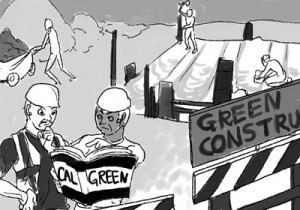CALGreen is code for success in 2011
Jan. 1, 2011, was always going to be a landmark day for firsts.
Middle schoolers (and inevitably some of us grown ups) gleefully awaited the moment they could wish at 11:11 on 1.1.11. Determined resolution-makers vowed that with the power of all those ‘1’s behind them, this would be the year they finally ran the marathon, wrote the Great American Novel or finished cleaning the garage.
Environmental policy makers seem to have been thinking along the same lines.
The new year rang in a new era for green legislature in California. On Jan. 1, the California Building Standards Commission enacted the California Green Building Code, the first mandatory green building code not just in the state, but also in the nation.
Most tenets of CALGreen are the familiar after-school special pitches we’ve been hearing for years: Waste less water. Recycle more trash. Remember that paint fumes are very, very bad.
The difference is that from here on out, these pitches will be mandated.
Mandating the quotas for recycling and water reduction in new buildings is costly, as is pretty much any step in the drive toward becoming environmentally solvent. It’s a legitimate argument for those who don’t want to pony up the extra cash that they themselves should be able to choose how to spend their money.
But California’s growing emphasis on green policy has been carrying the state toward this jump for some time, and now that the first step has been taken policy makers would be hard pressed to find one that better serves the state.
CALGreen gives us the benefit of a standardized building code that will be enforced in the same manner in every county across the state, freeing us from confusion about which codes supersede others. It keeps the state on the path to meet the goals of Assembly Bill 32, California’s Global Warming Solutions Act. There’s even talk the new codes could create additional green industry jobs.
And in the end, it has the same added perk that all California precedents do, particularly the environmental ones: It compels the rest of the nation to sit up and take notice. It’s a safe bet that as CALGreen moves forward, other states will begin to draft similar legislature.
Although CALGreen’s requirements of buildings that are already well-established are more relaxed, all new construction sites — even ones that are already underway — are fair game; which means it won’t affect EVK, but it could certainly affect the University Village remodel or any number of projects in USC’s 30-year Master Plan.
USC Sustainability recently promoted several seminars to help understand the impact CALGreen will have on construction in Los Angeles.
CALGreen isn’t perfect. Numerous organizations, including the Northern California Chapter of the U.S. Green Building Council and the Sierra Club, have expressed concern that the new codes will undermine the jurisdiction of Leadership in Energy and Environmental Design (LEED) and ultimately be a new source for the same kind of confusion it’s trying to clear up.
But California has faced far worse than conflicting legislature. Once the dust of the new codes settles, we can start focusing on its benefits.
According to the California Air Resources Board, CALGreen is estimated to save a CO2 equivalent of 3 million metric tons by 2020.
“This is something no other state in the country has done,” Tom Sheehy, undersecretary and designated acting secretary of the California State and Consumer Services Agency and Chair of the Building Standards Commission, said in a statement last year. “CALGreen will essentially revolutionize the way we build structures. By implementing a sensible, cost-effective foundation of green practices, our state will usher in a new era of greener communities.”
Kastalia Medrano is a sophomore majoring in print and digital journalism and associate managing editor for the Daily Trojan. Her column, “Green Piece,” runs Tuesdays.

